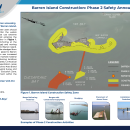
Fishing
Hunting and Fishing Plan
The U.S. Fish and Wildlife Service has released a final hunting and fishing plan for Chesapeake Marshlands National Wildlife Refuge (NWR) Complex in Maryland, which includes Blackwater and Eastern Neck NWRs. No significant changes were made between the draft and final versions of the Hunting and Fishing Plan. As part of the new plan, Blackwater and Eastern Neck NWRs will propose a non-lead requirement, which will take effect on September 1, 2026. Other changes that are now in effect include the use of straight wall cartridges during shotgun hunts, the incidental take of coyotes, and an early teal season.
The final plan can be viewed here.
Fishing FAQs
Can I fish at the refuge?
Yes, recreational fishing and crabbing are permitted at the refuge, but there are restrictions. Maryland state regulations apply while fishing and crabbing on the refuge. No special refuge permits are required; however, a valid state Chesapeake Bay and Coastal Sport Fishing License is required to fish in the Blackwater River and the Little Blackwater River. Please check with the Maryland Department of Natural Resources for complete details on fishing and crabbing regulations in Maryland.
Commercial fishing and crabbing are prohibited on the refuge.
Where can I fish at the refuge?
Fish and crabbing in refuge waters are restricted to boats and the Key Wallace Drive roadway (causeway) across the Little Blackwater River. Fishing from the Key Wallace causeway is open during daylight hours, year round.
While fishing on the refuge, anglers must remain in their boats at all times.
No fishing or crabbing is permitted from any other refuge shoreline, including the Wildlife Drive.
Most of the shoreline on Blackwater NWR is marsh and is not suitable for shoreline fishing. The only shoreline fishing available is from the causeway over the Little Blackwater River on Key Wallace Drive. Please note that, due to safety concerns, parking along the causeway is no longer allowed. Day use parking is available at the west end of the causeway at the entrance to Wildlife Drive (indicated on map below). Trailer parking is not permitted at this location. Anglers are allowed to stop temporarily on the causeway to load/unload gear before parking.
Are there other restrictions?
Yes, refuge-owned waters include large portions of the Blackwater and Little Blackwater Rivers and the associated expansive shallow water marsh areas. These waters are closed from October 1st through March 31st every year to protect migrating waterfowl (see map below). This closure does not apply to shoreline fishing on the Key Wallace causeway.
Anglers can fish with live bait; however bait cannot be collected from the refuge or released into refuge waters.
Fishing is only during daylight hours.
The Wildlife Drive is closed to fishing as it is dedicated to wildlife watching and photography. This is the only area of the refuge dedicated to these activities from a vehicle. We do not have sufficient parking for anglers, and fishing the banks would disturb the wildlife that viewers have come to see.
Where can I launch a boat?
See the Boating, Motorized and Boating, Non-motorized pages.
2025-26 waterfowl hunting advisory for the Blackwater River (Green Paddling Trail).
NOTICE TO BAY BOATERS: There is a safety zone around and adjacent to Barren Island during the construction of breakwaters. Please see the bulletin below for details. To find out more about the construction at Barren Island, please visit this website.
What species of fish can be caught here?
Fishing on the refuge in the Blackwater River is fair for tidal largemouth bass (black bass), striped bass (rockfish), white and yellow perch, black crappie, and channel catfish. The Little Blackwater River is a very popular spot for the spring run of white perch. Other species available in the waters of the Refuge are carp, bluegill and pickerel, and more recently the invasive snakehead. Information on these fish can be found at Maryland DNR's "Fish Facts" page.
You Can Help Us!
Pack it in, pack it out! Please do not litter, and help pick up trash that others have left behind.




